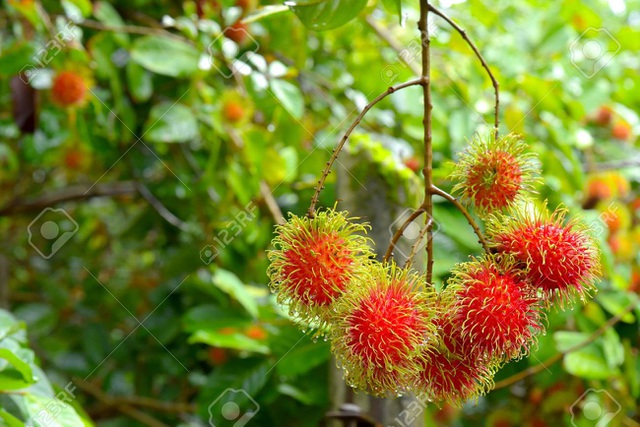Rambutan (Nephelium lappaceum) is a tropical fruit belonging to the family Sapindaceae. The word rambutan is derived from the Malay word rambut which means “hair”, a reference to the numerous hairy protuberances of the fruit. The fruit is often red but sometimes yellow. When peeled open, it reveals a sweet, white flesh clinging to a woody seed.1
Origin and distribution
It is probable that rambutans are native to the Malay archipelago. However, the origin of the rambutan is not clear as it has been cultivated for a very long time.2 Today, rambutan trees are cultivated mostly in Southeast Asia. It has also become popular in other tropical countries, especially Central America.3

The Rambutan
Rambutan fruit has long been recognized as the “golden” fruit of Vietnamese agriculture, not only brings high nutritional value, but also provides good economic efficiency for growers. This fruit, with a hairy outer shell, appears in two colors – red and yellow, and has a quite sweet and slightly sour flavor. Rambutan is also considered one of the signature summertime fruits that tourists must try when they come to Vietnam.
This fruit today has many varieties with different properties and flavors.

Photo: dantri.com.vn
Some of the popular types of rambutans in Vietnam and their characteristics are listed as follow:
- The longan rambutan: has an oval shape with short hairs, the pods when ripe gradually change from green to yellow, pink and finally red. Since the weight of the fruit is quite small (20-30g), it is called Longan rambutan by farmers. This fruit is also known as the sugar rambutan because when eaten, the flesh of the rambutan is crispy and has a sweetness like sugar. Additionally, the price of the longan rambutan is quite cheap and easy to buy.
- Java: This is a rambutan variety imported mainly from Indonesia and Thailand. The characteristics of this type of rambutan is that the flesh does not stick to the seeds, presenting in large size, long hair with a delicate taste. The Java rambutan and the longan rambutan are the two popular varieties supplying most of the Vietnamese domestic market.
- Thai rambutan: also known as Rong-rieng rambutan and is a relatively popular type of rambutan recently. This rambutan has a quite large shape, weight from 50-70 g / fruit with thick flesh and very small, flat seeds. When ripe, the skin is red, very attractive to consumers. When eating Thai rambutan, the meat is slightly sweet, so it is very suitable for people who like to eat fruits that are not too sweet. The price of Thai rambutan is relatively high, however, because of its deliciousness, many people are still willing to buy it for their families to enjoy.
How to eat
For tourists who are first to encounter this type of fruit, you may be confused at how to eat it since rambutan has a hairy and thick outside layer. But don’t be too bothered, once you learn how to eat the rambutan, you will find it very simple and delicious.

Photo: baocongthuong.com
First, place the rambutan firmly on the flat surface and hold at both ends. Slide the sharp knife along the center of the fruit, prepare to cut it in half. Cut gently on the skin but not on the pulp. Squeeze the fruit halfway around the stem to lengthen the cut. You can also use your thumb to tear the peel or even bite rambutan in half. Just keep in mind that the spines are soft and harmless, but the peel is inedible and can be a bit bitter.
Where are rambutans grown in Vietnam
As a fruit native to Southeast Asia, rambutan today is also grown in tropical climates around Vietnam. In particular, rambutan java is a common variety found in the area of Dong Nai, Ben Tre, Vinh Long; whereas the Longan rambutan is usually planted in Dong Thap, Can Tho or Tra Vinh.
Early rambutan fruit will be harvested around early May and the main season rambutan will be collected around early July each year. Therefore coming to these rambutan orchards by this time of the year, visitors can both admire the magnificent Vietnamese rural beauty, immerse themselves in nature’s scent as well as enjoy the best rambutan fruits in the best season.
Benefits of rambutans
People often warn that eating too much rambutan will increase the heat in your body. However, if you eat it in moderation, rambutan will bring you quite a lot of benefits. This fruit provides a large amount of nutrients from nature including calcium, vitamin B3, vitamins A and B9. It is these minerals and vitamins that work to support strong bones, enhance weight loss, and provide compounds with anti-parasitic properties. In addition, the juice of rambutan leaves also has a special effect, helping to nourish and supplement the scalp. On top of that, the seeds of this fruit also contain natural anti-diabetic properties.

Photo: 12kimma.vn
Food made from rambutan
This summer fruit is not only eaten as a fresh fruit, but also an ingredient for processing into delicious and nutritious dishes. A top one among those is the Vietnamese signature dessert – Che Khuc Bach which uses rambutan as a main topping.
Variant names
Common name: Rambutan, 红毛丹.
Scientific name: Nepheliumlappaceum.10
Indonesian and Malay name: Rambutan.
Thai name: Ngoh, phruan.11



